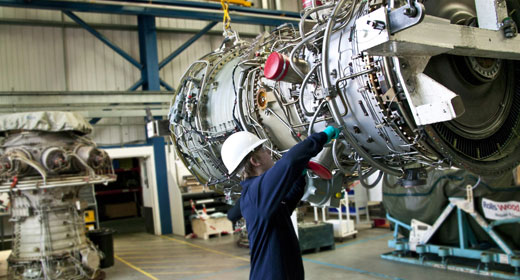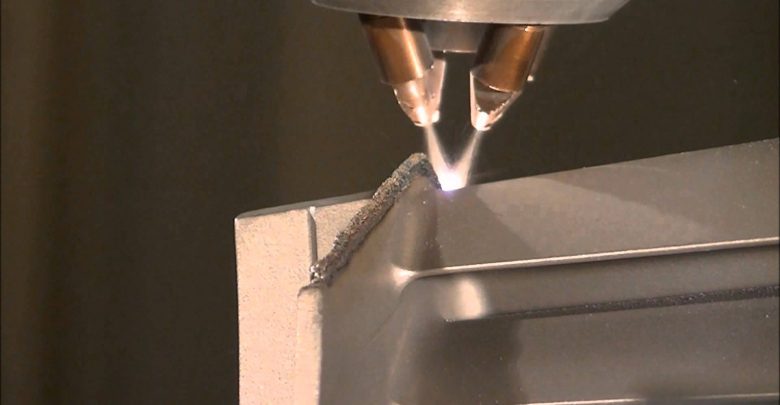Optomec, the New Mexico-based developers of Laser Engineered Net Shaping (LENS) and Aerosol Jet Printing (AJP) metal 3D printers, has launched a new Return On Investment (ROI) assessment tool.
Built on Optomec’s own remanufacturing experience, the cost calculator is reportedly able to assess the profitability of automated laser cladding equipment for gas turbine Maintenance and Repair Operations (MRO). By gathering customer-specific data in key areas, the tool enables companies to produce a full report, calculating the cost savings of switching to automated laser cladding, compared to the customer’s existing process.
“Despite the fact that many MROs have moved to automated processes, the majority of turbine and compressor blade repair is still done manually today,” said Mike Dean, Marketing Director at Optomec. “In our work with customers, we recognized that a wide range of factors contribute to building the business case for automated laser cladding and that is why we felt the need to develop this tool.”

Optomec’s MRO credentials
Founded in 1997 and headquartered in Albuquerque, Optomec is known for its LENS and AJP proprietary additive manufacturing technologies. Based on a form of Direct Energy Deposition (DED) 3D printing, LENS printers use a metal powdered feedstock that is blown through a nozzle and then melted on contact with a laser array to 3D print parts. Given its ability to work with curved surfaces, LENS systems are ideal for precision applications such as repairing metal parts or metal cladding.
Since the launch of its CS 600 and 800 3D printers, the company has released a slew of updates, designed to improve upon the features of its AM systems. Upgrades provided over the last year, for instance, have included a new (LDH 3.X) deposition head and developments allowing LENS machines to be used to deposit any aluminum alloy. These improvements have allowed Optomec’s systems to be utilized in a range of applications which include producing bi-metallic rocket engine parts for NASA, and 3D printing turbine blade sensors for Japanese company Taiyo Nippon Sanso Corporation (TNSC).
Optomec has also invested heavily in developing its technologies for MRO applications. In November 2019 for example, the company released its AutoCLAD software tool which was designed to accelerate the use of 3D printing for repair. The software enabled enterprises working with aircraft engines and industrial gas turbines, to repair both worn and damaged components. In addition, having acquired CNC and laser cladding machine supplier Huffman LLC in December 2018, the company recently introduced robotic automation to its Huffman line of 3D Metal Additive Repair machines.
Wielding the knowledge gained from its experience in MRO and gas turbine repair, Optomec has now released an ROI assessment tool, which demonstrates the potential cost savings of embracing automation.

Calculating the benefits of 3D printing
Optomec’s cost calculator was designed by Terry VanderWert, a laser processing expert and 40 year veteran of the industry. It builds on VandeWert’s findings released in February 2020, which concluded that automated metal additive manufacturing solutions could provide a 180% ROI over the manual processes used today. The study, titled “The Business Case for Automated Laser Cladding in Aviation Component Repair: Five Lessons Learned,” included in-depth quality, cost, and ROI comparisons of manual welding and automated laser cladding methods.
Moreover, given that Optomec has remanufactured more than 10 million turbine blades in 15 countries around the world, its customers can rest assured that the calculator’s analysis is well-founded. As a result, the newly-launched tool has been built from the ground up to help gas turbine repair customers, gain a deeper insight into the cost savings associated with moving to an automated process.
Utilizing the software, users will be able to access customer-specific data in key areas, including a full report that calculates the cost savings of moving to an automated laser cladding process. In addition to calculating ROI, the tool also estimates the cost per part, payback period, net present value and internal rate of return, of converting from traditional manufacturing methods such as manual TIG welding.
“With our ROI calculator we can help more MROs understand the real value and impact automation can have,” added Dean. “In addition to the cost savings, there are huge benefits in terms of higher repeatability and superior metallurgy from automated laser cladding.”
Makers and manufacturers interested in using the calculator to find out more the potential cost savings of using automated laser cladding techniques, can access the tool here.
MRO in the 3D printing industry
Aerospace businesses have also found the maintenance and repair applications of 3D printing technology to be particularly useful, and collaborated with a number of AM companies to open new facilities.
Etihad Engineering, the MRO division of the Etihad Aviation Group for instance, has worked with German 3D printer manufacturers EOS and BigRep, to open an additive manufacturing complex in Abu Dhabi. Featuring two MRO-approved 3D printers, the printing lab produces aircraft parts using powder-bed fusion technology.
Similarly, aerospace and defense supplier Collins Aerospace Systems has opened an aerospace innovation hub for advanced MRO in Singapore. Located at the Collins Changi MRO Campus in East Singapore, the new facility houses the company’s first additive manufacturing lab outside the United States.
The U.S. Marine Corps Air Station (MCAS) based in Iwakuni, southern Japan, are also using 3D printing to keep F/A-18 Hornet multirole fighters airborne. MCAS Iwakuni engineers have printed two products which reduce the time it takes to repair the fighter jets.
You can now nominate for the 2020 3D Printing Industry Awards. Cast your vote to help decide this year’s winners.
To stay up to date with the latest 3D printing news, don’t forget to subscribe to the 3D Printing Industry newsletter or follow us on Twitter or liking our page on Facebook.
Looking for a job in the additive manufacturing industry? Visit 3D Printing Jobs for a selection of roles in the industry.
Featured image shows an engineer from repair and overhaul specialists MRG, working on the MRO of a jet engine. Image via MRG.



